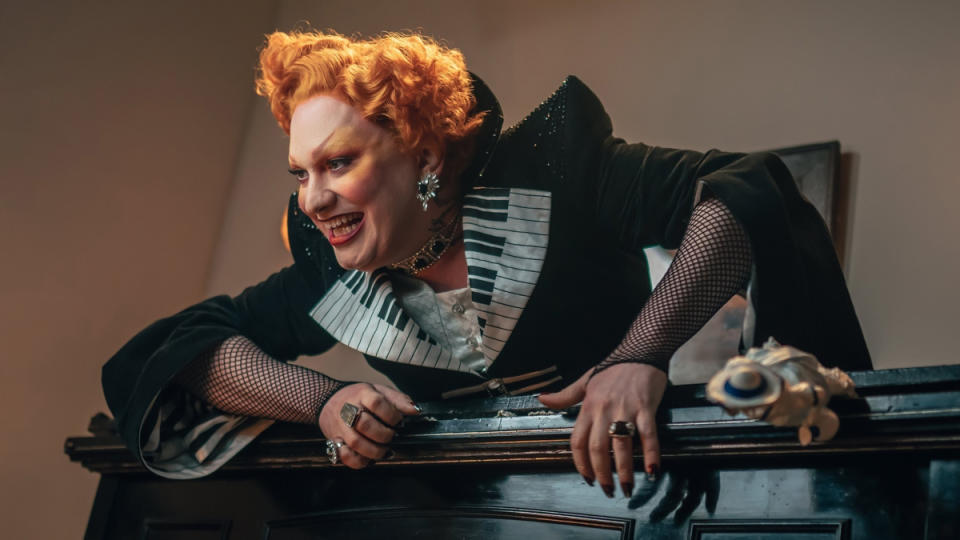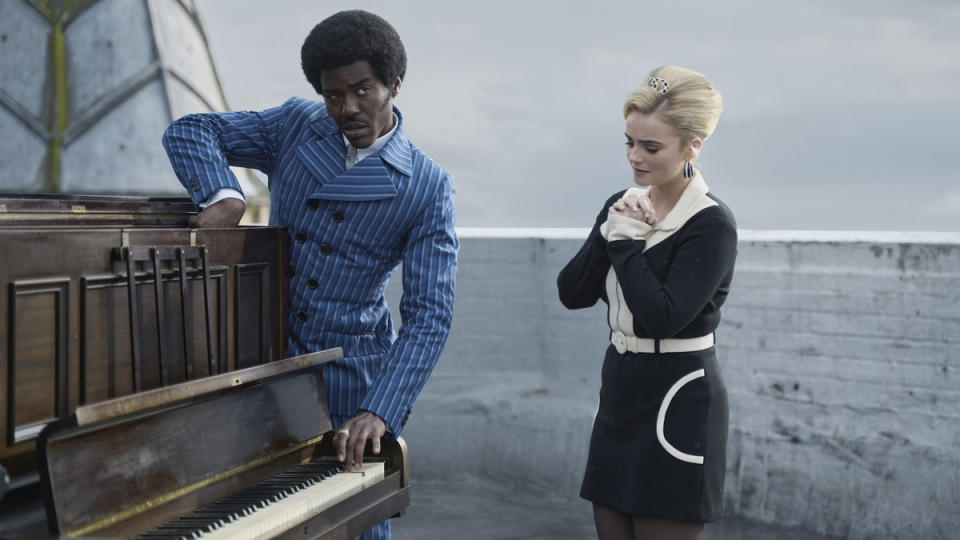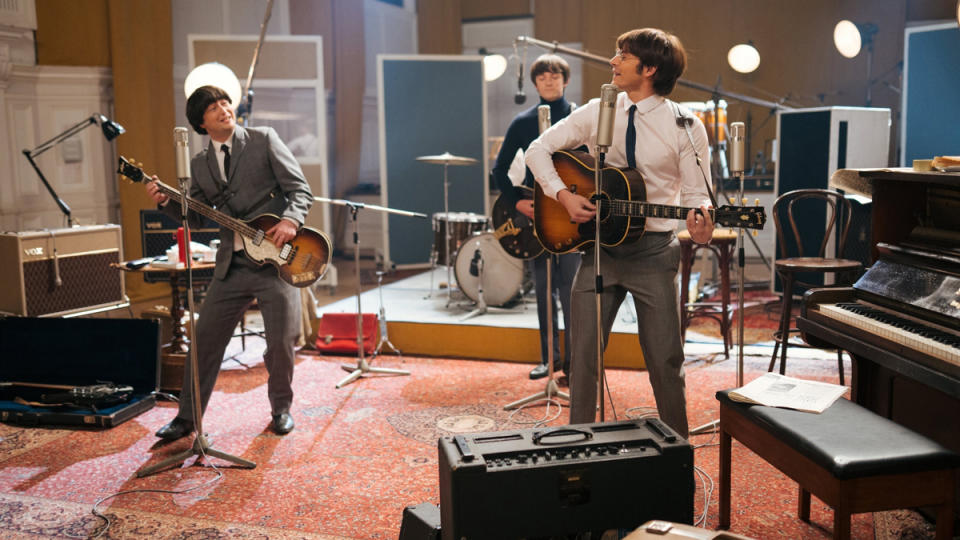Doctor Who’s “The Devil’s Chord”: Behind the Scenes of The Doctor Meeting The Beatles (At Last)
- Oops!Something went wrong.Please try again later.
- Oops!Something went wrong.Please try again later.
- Oops!Something went wrong.Please try again later.
- Oops!Something went wrong.Please try again later.
- Oops!Something went wrong.Please try again later.
The post Doctor Who’s “The Devil’s Chord”: Behind the Scenes of The Doctor Meeting The Beatles (At Last) appeared first on Consequence.
[Editor’s note: The following contains spoilers for Doctor Who, Season 1 Episode 2, “The Devil’s Chord.”]
The Doctor has met plenty of famous figures during his adventures on Doctor Who, from Queen Elizabeth I to Rosa Parks to H.G. Wells. So, according to executive producer/showrunner Russell T Davies, “it’s amazing that The Doctor hasn’t met The Beatles before, especially since they both came into existence in 1963.”
By that, Davies means that Doctor Who first premiered on the BBC in November 1963, while The Beatles recorded their first album in February of that year. And that’s the point in space and time which the 15th Doctor (Ncuti Gatwa) and his new companion Ruby Sunday (Millie Gibson) visit in “The Devil’s Chord,” streaming now on Disney+.
“That script reading was special for sure,” Millie Gibson tells Consequence. “It was just levels above anything I’ve ever read before. The thing that gave me goosebumps, when I read it, was the stage directions for the end: ‘And the TARDIS doors go ‘buh-boo.'”
The initial inspiration for “The Devil’s Chord” came from a friend of Davies, who said that if he had a TARDIS, he’d want to see The Beatles record their first album. Not a mind-blowing idea, except that said friend is 23 years old. “The fact that he said that as a young person made me think, ‘Oh, that’s interesting,'” Davies says. “If I’d said it, I think, yeah, that’s what a 61-year-old says. But that someone so young was interested in The Beatles made me sit up.”
And as soon as Davies started thinking about The Beatles, his years of experience as a television producer led him instantly to a story idea. “I knew The Beatles’ music is way too expensive, even with a lovely Disney budget. So I thought, right, you couldn’t ever use any of their music — lo and behold, you created the plot in that second. It was instantly there. I was like, ‘Oh, that’s good. You go to watch the Beatles, and they’re singing the wrong thing, time’s gone wrong, and suddenly you’re in the middle of a Doctor Who story.’ So that was great.”
In “The Devil’s Chord,” Ruby tells The Doctor that she wants to visit the iconic band in 1963. When they arrive at Abbey Road Studios, though, they discover that the band (featuring Chris Mason as John Lennon and George Caple as Paul McCartney) has lost their mojo — in fact, the concept of music has nearly died out, thanks to the supernatural interference of a new villain named Maestro.

Doctor Who (Disney+)
Playing Maestro is RuPaul’s Drag Race winner and Broadway/cabaret performer Jinkx Monsoon, who says she loves the character because “it’s kind of where science fiction meets Greek mythology — you could look at them as a god or as a demon, but what they are at the end of the day is an extremely powerful embodiment of music. And as a musical person, I felt very ready for the challenge.”
Monsoon and Davies had been friends prior to her casting, meeting through a longtime friend of Davies. Davies says that “it was just kind of natural, really, that I wrote this part. I didn’t think of Jinkx when I was writing it, but as soon as I’d written it and handed it in, I was like, ‘Oh God, there’s an obvious choice for this.'”
Maestro and The Doctor end up waging musical war with each other during the episode’s climax, just one of the episode’s many melodic moments. In fact, it’s hard not to notice that Season 15 of Doctor Who is a lot more musical, between “The Goblin Song” in Christmas special “The Church on Ruby Road” and the original songs packed into “The Devil’s Chord.
“I think my entire career has been heading this way. I’ve always been wanting to do that,” Davies says. “And I’ve been working very closely for many years with Murray Gold, our composer, and he’s been putting songs into Doctor Who for a long time, way back to David Tennant’s first adventure in ‘The Christmas Invasion.’”
The trick to these interludes, Davies says, is “to find the right emotional pitch. People who write musicals, when they talk about their craft and their skill, it’s very clear how well-pitched it’s got to be to reach the emotional height or the plot necessity of putting things into song. And I think I’m finally finding moments which are deserved.”
This includes one of the episode’s loveliest sequences, an interlude in which Ruby plays an original song on the rooftop of Abbey Road Studios. Ruby’s talent for music is something Davies established early about the character, because as he says, “She’s ended up in London quite short of money and a little bit stuck at home, stuck with her mom and, let’s face it, in the middle of a cost-of-living crisis. So I wanted to give her an extra dimension. Not an award-winning pianist, but just someone playing gigs with her mates in a local pub for 50 quid a night. I love that. I thought that’s a really salty, interesting life. I could write stories about that little band and her mate Trudy, I think they’re a great little bunch.”

Doctor Who (Disney+)
So in developing “The Devil’s Chord,” Davies realized that in the episode, “she’s the only person who has any music in her in the world,” and thus Gold was asked to write “Trudy’s Song.”
“It’s like the first piece of music that’s in the world at that time,” Gatwa says. “Also, it’s the first time that The Doctor’s tasking Ruby with responsibility — like, ‘I’ve seen something in you that’s magical and can be used to save the world.’ That little section very much symbolizes that these two characters are in this.”
“That piece of music that Murray Gold wrote is so moving. You do feel like music’s coming back to the world,” Gibson says.
When asked if there was any pushback on the length of the sequence, Davies says that “always, at some point, someone says, ‘Can you cut that down?’ That episode’s long as well, it goes to 50, when these episodes are meant to be 45 minutes. But we just went, we’re not cutting this. We’re not.”
Gibson, for the record, does not actually play the piano; the “Trudy’s Song” sequence was a combination of doubles and good acting. It turns out Consequence is the first publication to ask her if she knows how to play — as Gatwa says to Gibson, though, “I’m not surprised that you haven’t been asked that, because I watched the playback, and you sold that so well, to the point where I also thought that you played piano. Even down to your little shoulder moves. You acted very well, darling.”
While we’re talking about what’s real and what wasn’t, none of the episode was actually shot at the real Abbey Road — instead, the production team recreated the 1960s recording studio in Wales. “We found a suitable street in Cardiff. And it just goes to show, my gosh, what locations and props and the art department can do is just incredible,” Gatwa says. “They just create the most incredible sets. It’s so much nostalgic fun.”
In the lead-up to the show’s premiere, Gibson and Gatwa have since been to visit the real Abbey Road, but Gatwa’s frank about it: “I like our Abbey Road better. Obviously Abbey Road is iconic and incredible, but ours was better.”
At the very least, the recreation was impressive in its scale, says Monsoon: “It’s very incredible as an actor to get to play in such a large, fully realized set. In terms of production elements, this was the biggest production I’ve ever worked on. And I just cannot speak highly enough of every member of the crew — everyone I interacted with, every person I spoke with, even just in an email were just wonderful and loved getting to do their job. And so it’s a huge privilege to be invited into such a fully realized production. It made doing the work really fun and easy because everyone brought a good attitude to it.”

Doctor Who (Disney+)
Monsoon says she also doesn’t have much experience with instruments: “I play ukulele and I used to play the double bass, so I was kind of picking that back up while we were on set, but very rudimentary. But I have had training in music theory — so even though I don’t play these instruments, I essentially know what supposed to happen with them.”
According to her, this meant that the climatic “music battle” between Maestro and The Doctor “was 25% music knowledge, 75% dance and choreography.”
As for the episode-ending “final twist,” Gatwa and Gibson say it took about four days to film all the various elements of the surprise musical number, bringing together the full cast from the episode as well as dozens of extras. “That’s very quick for a sequence like that, and all the components that they had,” Gatwa says. “They like to throw us into the deep end and see whether we sink or swim.”
“Even when we watch it back now, I’m like, ‘Oh yeah, there’s tap dancing in it as well.’ It’s just so much fun,” Gibson adds.
Davies says that “The Devil’s Chord” might be the last episode of the season to include a full-tilt musical number, though “what you do get elsewhere in the series are the enormous great tunes of Murray Gold. The final episode, which is called ‘Empire of Death’ — the last five, 10 minutes of that are the most magnificent orchestra.”
If you’re curious, early on, Davies did try to figure out a workaround to the rights issues surrounding the music of The Beatles. “We literally went, ‘Can we have like the first two notes of “Please Please Me”?’ No. We literally got to the state of going, ‘Can we have just one note of “Please Please Me?”‘ And they said no. And I was sitting there going, ‘You can’t copyright one note, a note is a note. You don’t own that note!'”
A lawyer, though, advised him not to push it — warning him to not even try referencing Beatles lyrics in the dialogue. “I think it’s actually a shame,” Davies says. “It would’ve been lovely in many ways to include that music, but hopefully I made a plus out of it instead.”
The new season of Doctor Who is streaming now on Disney+. New episodes premiere Fridays.
Doctor Who’s “The Devil’s Chord”: Behind the Scenes of The Doctor Meeting The Beatles (At Last)
Liz Shannon Miller
Popular Posts
Student Walk Out on Jerry Seinfeld's Duke Commencement Speech
Apple Destroys Vintage Instruments in Tone-Deaf New Commercial for iPad Pro
Jon Stewart Mocks “Anti-Woke” Comedians: "Are You That F*cking Unimaginative?"
Kate Hudson Covers Stone Temple Pilots' "Vasoline" Ahead of Debut Album: Watch
AC/DC Unveil Photo of New Band Lineup Ahead of First Tour in Eight Years

